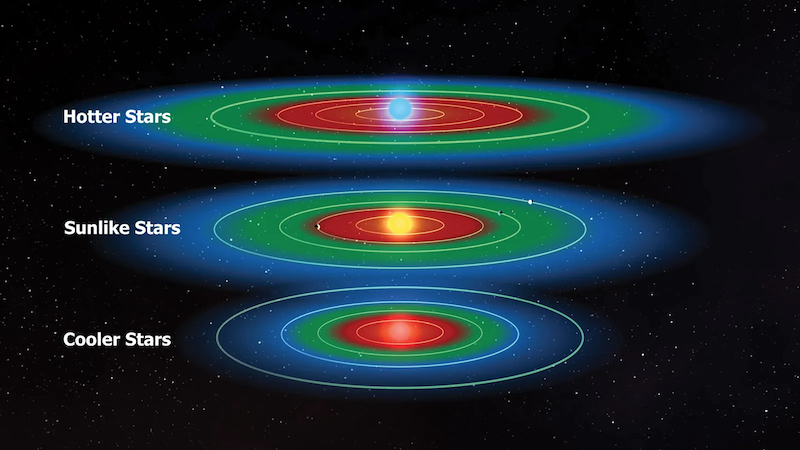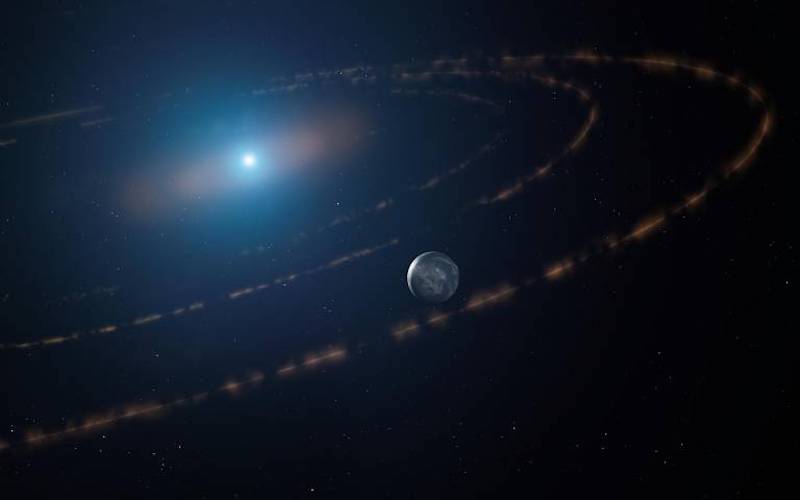
A habitable zone planet?
We know 4,000+ exoplanets orbiting distant stars in our Milky Way galaxy. Some orbit the dim cores of former sun-like stars called white dwarfs. Such stars are slowly cooling, fading embers. But can there be planets in the habitable zones of such stars? And could those planets have life, even as the host star slowly dimmed? An international group of astronomers may have an answer to the first question. They said on February 11, 2022, that they have evidence of a possible still-intact planet in the habitable zone of the white dwarf WD1054–226.
Astronomers have found white-dwarf planets before, but never in a white dwarf’s habitable zone. If confirmed, this habitable zone planet for WD1054–226 will be the first such planet ever found.
The peer-reviewed Monthly Notices of the Royal Astronomical Society published their study on February 8.
The 2022 lunar calendars are still available. Order yours before they’re gone!
Can white dwarfs have habitable zones?
Habitable zones for rocky planets – sometimes called Goldilocks zones – are where temperatures are not too hot and not too cold for liquid water to exist. Earth sits squarely in our own sun’s habitable zone. We’re far enough from our sun so that all our water doesn’t boil away. We’re close enough so that water can exist in a form other than solid ice.
The habitable zone for a white dwarf star would be closer to the star than Earth is to our sun (closer than our average distance of 93 million miles, or 150 million km). It would need to be, because white dwarfs aren’t active stars anymore. They’re glowing mainly with residual heat and light from their former glory days.
Plus, white dwarfs themselves are small. Consider that over a million Earths could fit inside our sun. But a typical white dwarf is about Earth’s size.
Is there really a planet in the habitable zone of white dwarf WD1054–226? If so, it would be an exciting discovery.
Unusual clouds of planetary debris
The researchers studied this white dwarf using the ULTRACAM high-speed camera on the New Technology Telescope at the La Silla Observatory in Chile.
They didn’t see the planet directly. But – as so often happens with distant exoplanets – they saw mysterious dips in the light coming from the white dwarf. To this group of researchers, the dips in white dwarf light suggested the presence of 65 small, dense clouds of dust – planetary debris orbiting the dead white dwarf star – transiting or passing in front of the white dwarf with great regularity. To explain what the astronomers observed, the clouds would need to be evenly spaced. They’d need to orbit the star every 25 hours. This 25-hour period was later confirmed by NASA’s Transiting Exoplanet Survey Satellite (TESS).
And the clouds would need to dim the white dwarf’s light every 23 minutes. What could keep clouds of debris so evenly spaced? These astronomers think a planet could.

A habitable zone planet for WD1054–226?
The odd regularity of these orbiting debris clouds is what intrigues astronomers. They said it’s tempting to think of them as being artificial. But the researchers have an alternate solution. They said the gravity of an as-yet unseen planet could maintain the regular spacing of the clouds. Jay Farihi at University College London led the astronomy team. He said:
This is the first time astronomers have detected any kind of planetary body in the habitable zone of a white dwarf. The moon-sized structures we have observed are irregular and dusty (e.g. comet-like) rather than solid, spherical bodies. Their absolute regularity, one passing in front of the star every 23 minutes, is a mystery we cannot currently explain.
An exciting possibility is that these bodies are kept in such an evenly spaced orbital pattern because of the gravitational influence of a nearby planet.
Without this influence, friction and collisions would cause the structures to disperse, losing the precise regularity that is observed.
Waiting for confirmation on the habitable zone planet
So does this planet exist? We don’t know yet. Farihi said:
The possibility of a planet in the habitable zone is exciting and also unexpected. We weren’t looking for this. But it’s important to keep in mind that more evidence is necessary to confirm the presence of a planet. We cannot observe the planet directly. So confirmation may come by comparing computer models with further observations of the star and orbiting debris.

Does habitable mean inhabited?
If the planet is confirmed … could it be inhabited? Being in a star’s habitable zone doesn’t guarantee habitability. And the habitable zone for a cool, dim white dwarf star would be a far less hospitable place than, for example, our own solar system’s habitable zone, where Earth – warmed and energized by our sun – exists as a garden world.
If the planet orbiting WD1054–226 does exist and is habitable (capable of having liquid water on its surface), it probably would have become so fairly recently, these astronomers pointed out. That’s because WD1054–226 wasn’t always a white dwarf. It would have started as a star not unlike our sun. It would have become a red giant as it died. And, at that point, its outer layers would have expanded outward, engulfing its own inner solar system. Astronomers describe this as the red giant star “sweeping clear” the region where the planet now appears to orbit.
So, if it exists, we don’t know how a planet came to orbit in the habitable zone of white dwarf WD1054–226. Any planets in that region should have been cleared out long ago.
However it got there (if it is there), the planet’s habitable conditions wouldn’t have kicked off until about a billion years ago, according to the researchers. Could there be microbial life on this strange white dwarf planet? Maybe. And if so, maybe it’ll evolve.
After all, these astronomers calculate, this habitable period should last at least 2 billion years, up to another billion years from now.
A glimpse into our future
One last note. Like most stars, our sun will also ultimately become a red giant star, expanding into the inner solar system, engulfing Mercury, Venus and probably Earth. That’ll happen some 4 1/2 billion years from now. The sun will then shrink down to a white dwarf. As Farihi said:
Since our sun will become a white dwarf in a few billion years, our study provides a glimpse into the future of our own solar system.

Bottom line: For the first time, astronomers have found a possible habitable zone planet orbiting a white dwarf star. Weird, evenly spaced clouds of debris hint at the planet’s existence.
Source: Relentless and complex transits from a planetesimal debris disc
The post A habitable zone planet for a dead star? first appeared on EarthSky.
0 Commentaires